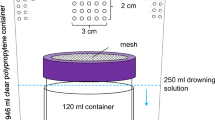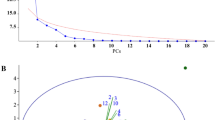Abstract
Biocontrol agents such as parasitic wasps use long-range volatiles and host-associated cues from lower trophic levels to find their hosts. However, this chemical landscape may be altered by the invasion of exotic insect species. The spotted-wing drosophila (SWD), Drosophila suzukii (Diptera: Drosophilidae), is a highly polyphagous fruit pest native to eastern Asia and recently arrived in South America. Our study aimed to characterize the effect of SWD attack on the volatile organic compounds (VOCs) of blueberries, a common host fruit, and to correlate these odor changes with the olfactory-mediated behavioral response of resident populations of Trichopria anastrephae parasitoids, here reported for the first time in Uruguay. Using fruit VOC chemical characterization followed by multivariate analyses of the odor blends of blueberries attacked by SWD, we showed that the development of SWD immature stages inside the fruit generates a different odor profile to that from control fruits (physically damaged and free of damage). These differences can be explained by the diversity, frequency, and amounts of fruit VOCs. The behavioral response of T. anastrephae in Y-tube bioassays showed that female wasps were significantly attracted to volatiles from SWD-attacked blueberries when tested against both clean air and undamaged blueberries. Therefore, T. anastrephae females can use chemical cues from SWD-infested fruits, which may lead to a successful location of their insect host. Since resident parasitoids are able to locate this novel potential host, biological control programs using local populations may be plausible as a strategy for control of SWD.




Similar content being viewed by others
Availability of Data and Material
Data is available from the corresponding authors on request.
Code availability.
Code is available from the corresponding authors on request.
Code Availability
Code is available from the corresponding authors on request.
References
Adams RP (2007) Identification of essential oil components by gas chromatography/mass spectrometry, 4th edn. Allured Publ, Carol Stream
Anderson PK, Cunningham AA, Patel NG et al (2004) Emerging infectious diseases of plants: pathogen pollution, climate change and agrotechnology drivers. Trends Ecol Evol 19:535–544. https://doi.org/10.1016/j.tree.2004.07.021
Atallah J, Teixeira L, Salazar R, Zaragoza G, Kopp A (2014) The making of a pest: the evolution of a fruit-penetrating ovipositor in Drosophila suzukii and related species. Proc Biol Sci 281(1781):20132840. https://doi.org/10.1098/rspb.2013.2840
Biondi A, Wang X, Miller JC et al (2017) Innate olfactory responses of Asobara japonica toward fruits infested by the invasive spotted wing drosophila. J Insect Behav 30:495–506. https://doi.org/10.1007/s10905-017-9636-y
Biondi A, Wang X, Daane KM (2021) Host preference of three Asian larval parasitoids to closely related Drosophila species: implications for biological control of Drosophila suzukii. J Pest Sci 94:273–283. https://doi.org/10.1007/s10340-020-01272-0
Bolda MP, Goodhue RE, Zalom FG (2010) Spotted wing drosophila: potential economic impact of newly established pest. Giannini Foundation of Agricultural Economics, University of California. Agric Resour Econ Update 13:5–8
Carrasco D, Desurmont GA, Laplanche D, Proffit M, Gols R et al (2017) With or without you: Effects of the concurrent range expansion of an herbivore and its natural enemy on native species interactions. Glob Change Biol 24:631–643
Cha D, Adams T, Rogg H, Landolt PJ (2012) Identification and field evaluation of fermentation volatiles from wine and vinegar that mediate attraction of spotted wing drosophila, Drosophila suzukii. J Chem Ecol 38:1419–1431
Chabaane Y, Laplanche D, Turlings TC, Desurmont GA (2015) Impact of exotic insect herbivores on native tritrophic interactions: a case study of the African cotton leafworm, Spodoptera littoralis and insects associated with the field mustard Brassica rapa. J Ecol 103:109–117
Cini A, Ioriatti C, Anfora G (2012) A review of the invasion of Drosophila suzukii in Europe and a draft research agenda for integrated pest management. B Insectol 65:149–160
Cloonan KR, Abraham J, Angeli S et al (2018) Advances in the chemical ecology of the spotted wing drosophila (Drosophila suzukii) and its applications. J Chem Ecol 44:922–939. https://doi.org/10.1007/s10886-018-1000-y
Cusumano A, Harvey JA, Bourne ME, Poelman EH, de Boer JG (2020) Exploiting chemical ecology to manage hyperparasitoids in biological control of arthropod pests. Pest Man Sci 76:432–443
de la Vega GJ, Corley JC (2019) Drosophila suzukii (Diptera: Drosophilidae) distribution modelling improves our understanding of pest range limits. Int J Pest Manage 65:217–227. https://doi.org/10.1080/09670874.2018.1547460
de la Vega GJ, Corley JC, Soliani C (2020) Genetic assessment of the invasion history of Drosophila suzukii in Argentina. J Pest Sci 93:63–75. https://doi.org/10.1007/s10340-019-01149-x
Desurmont GA, von Arx M, Turlings TCJ, Schiestl FP (2020) Floral odors can interfere with the foraging behavior of parasitoids searching for hosts. Front Ecol Evol 8:148. https://doi.org/10.3389/fevo.2020.00148
Farneti B, Khomenko I, Grisenti M et al (2017) Exploring blueberry aroma complexity by chromatographic and direct-injection spectrometric techniques. Front Plant Sci 8:617
Gilbert JL, Schwieterman ML, Colquhoun TA, Clark DG, Olmstead JW (2013) Potential for increasing southern highbush blueberry flavor acceptance by breeding for major volatile components. HortScience 48:835–843
Hamby KA, Becher PG (2016) Current knowledge of interactions between Drosophila suzukii (Diptera: Drosophilidae) and microbes, and their potential utility for pest management. J Pest Sci 89:621–630
Harvey JA, Fortuna TM (2012) Chemical and structural effects of invasive plants on herbivore–parasitoid/predator interactions in native communities. Entomol Exp Applic 144:14–26
Hervé MR, Nicolè F, Lê Cao K (2018) Multivariate Analysis of multiple datasets: a practical guide for chemical ecology. J Chem Ecol 44:215–234. https://doi.org/10.1007/s10886-018-0932-6
Horvat RJ, Schlotzhauer WS, Chortyk OT et al (1996) Comparison of volatile compounds from rabbiteye blueberry (Vaccinium ashei) and deerberry (V. stamineum) during maturation. J Essent Oil Res 8:645–648
Ibouh K, Oreste M, Bubici G et al (2019) Biological control of Drosophila suzukii: efficacy of parasitoids, entomopathogenic fungi, nematodes and deterrents of oviposition in laboratory assays. Crop Prot 125:104897
Jaworski CC, Bompard A, Genies L, Amiens-Desneux E, Desneux N (2013) Preference and prey switching in a generalist predator attacking local and invasive alien pests. PLoS ONE 8(12):e82231
Karageorgi M, Brńcker LB, Lebreton S et al (2017) Evolution of multiple sensory systems drives novel egg-laying behavior in the fruit pest Drosophila suzukii. Curr Biol 27:847–853
Keesey IW, Knaden M, Hansson BS (2015) Olfactory specialization in Drosophila suzukii supports an ecological shift in host preference from rotten to fresh fruit. J Chem Ecol 41:121–128
Krüger AP, Scheunemann T, Vieira JGA et al (2019) Effects of extrinsic, intraspecific competition and host deprivation on the biology of Trichopria anastrephae (Hymenoptera: Diapriidae) reared on Drosophila suzukii (Diptera: Drosophilidae). Neotrop Entomol 48:957–965. https://doi.org/10.1007/s13744-019-00705-5
Kruitwagen A, Beukeboom LW, Wertheim B (2018) Optimization of native biocontrol agents, with parasitoids of invasive pest Drosophila suzukii as an example. Evol Appl 11:1473–1497
Lantschner MV, de la Vega GJ, Corley JC (2019) Modelling the establishment, spread and distribution shifts of pests. Int J Pest Manag 65:187–189. https://doi.org/10.1080/09670874.2019.1575490
Lee JC, Wang X, Daane KM, Hoelmer KA, Isaacs R, Sial AA, Walton VW (2019) Biological control of spotted-wing drosophila (Diptera: Drosophilidae)—current and pending tactics. J Integr Pest Manag 10:13
Liu CM, Matsuyama S, Kainoh Y (2019) Synergistic effects of volatiles from host-infested plants on host-searching behavior in the parasitoid wasp Lytopylus rufipes (Hymenoptera: Braconidae). J Chem Ecol 45:684–692
Mair MM, Ruther J (2019) Chemical ecology of the parasitoid wasp genus Nasonia (Hymenoptera, Pteromalidae). Front Ecol Evol 7:184
Mumm R, Hilker M (2005) The significance of background odour for an egg parasitoid to detect plants with host eggs. Chem Senses 30:337–343
Nunney L (1996) The colonization of oranges by the cosmopolitan Drosophila. Oecologia 108(3):552–561
R Core Development Team (2019) R: a language and environment for statistical computing. R Foundation for Statistical Computing, Vienna
Revadi S, Vitagliano S, Rossi Stacconi MV, Ramasamy S, Mansourian S et al (2015) Olfactory responses of Drosophila suzukii females to host plant volatiles. Physiol Entomol 40:54–64
Rombaut A, Guilhot R, Xuéreb A, Benoit L, Chapuis MP, Gibert P, Fellous S (2017) Invasive Drosophila suzukii facilitates Drosophila melanogaster infestation and sour rot outbreaks in the vineyards. Roy Soc Open Sci 4:170117. https://doi.org/10.1098/rsos.170117
Scheidler NH, Liu C, Hamby KA, Zalom FG, Syed Z (2015) Volatile codes: correlation of olfactory signals and reception in Drosophila-yeast chemical communication. Sci Rep 5:14059
Schröder R, Hilker M (2008) The relevance of background odor in resource location by insects: a behavioral approach. AIBS Bull 58:308–316
Schulz AN, Lucardi RD, Marsico TD (2019) Successful invasions and failed biocontrol: the role of antagonistic species interactions. Bioscience 69:711–724. https://doi.org/10.1093/biosci/biz075
Stökl J, Strutz A, Dafni A et al (2010) A deceptive pollination system targeting drosophilids through olfactory mimicry of yeast. Curr Biol 20:1846–1852
Tochen S, Dalton DT, Nik W et al (2014) Temperature-Related Development and Population Parameters for Drosophila suzukii (Diptera: Drosophilidae) on Cherry and Blueberry. Environ Entomol 43:501–510
Urbaneja-Bernat P, Cloonan K, Zhang A et al (2021) Fruit volatiles mediate differential attraction of Drosophila suzukii to wild and cultivated blueberries. J Pest Sci. https://doi.org/10.1007/s10340-021-01332-z
Vet LEM, Dicke M (1992) Ecology of infochemical use by natural enemies in a tritrophic context. Annu Rev Entomol 37:141–172
Vieira JGA, Krüger AP, Scheuneumann T et al (2019) Some aspects of the biology of Trichopria anastrephae (Hymenoptera: Diapriidae), a resident parasitoid attacking Drosophila suzukii (Diptera: Drosophilidae) in Brazil. J Econ Entomol 113:81–87
Vieira JGA, Krüger AP, Scheunemann T et al (2020) Effect of temperature on the development time and life-time fecundity of Trichopria anastrephae parasitizing Drosophila suzukii. J Appl Entomol 144:857–865. https://doi.org/10.1111/jen.12799
Walsh DB, Bolda MP, Goodhue RE, Dreves AJ, Lee J, Bruck DJ (2011) Drosophila suzukii (Diptera: Drosophilidae): invasive pest of ripening soft fruit expanding its geographic range and damage potential. J Integr Pest Manag 2:1–8
Wang X, Kacar G, Biondi A, Daane KM (2016) Life-history and host preference of Trichopria drosophilae, a pupal parasitoid of spotted wing drosophila. Biocontrol 61:387–397
Wolf S, Boycheva-Woltering S, Romeis J, Collatz J (2020) Trichopria drosophilae parasitizes Drosophila suzukii in seven common non-crop fruits. J Pest Sci 93:627–638
Wollmann J, Schlesener DCH, Ferreira MS, Garcia FRM (2016) Parasitoids of Drosophilidae with potential for parasitism on Drosophila suzukii in Brazil. Drosophila Inf Serv 99:38–42
Woltz J, Megan J, Lee C (2017) Pupation behavior and larval and pupal biocontrol of Drosophila suzukii in the field. Biol Control 110:62–69
Acknowledgements
This paper is dedicated to the memory of Professor Wittko Francke, for his generous contribution to the growth of chemical ecology in Latin America. This project was funded by Grants from Agencia Nacional de Investigación e Innovación: FMV-1-2019-1-156089 and PD_NAC_2018_1_150632 (fellowship to GD). We thank Dr. Beatriz Goñi for kind help and advice in field collections, Daniela Mato for assistance in VOC collections, and Finca La Micaela for access to their organic farm.
Funding
This project was funded by grants from Agencia Nacional de Investigación e Innovación (ANII): FMV-1-2019-1-156089 and PD_NAC_2018_1_150632 (fellowship to GD).
Author information
Authors and Affiliations
Contributions
AG and GD conceived and designed research; GD, AG, and FT collected the data; AG identified the chemical compounds; FT led the parasitoid experiments; GD and AG led the analysis and writing of the manuscript. All authors contributed to the drafts and approved the manuscript.
Corresponding authors
Ethics declarations
Conflict of interest
All authors declare that they have no conflict of interest.
Supplementary Information
Below is the link to the electronic supplementary material.
Rights and permissions
About this article
Cite this article
de la Vega, G.J., Triñanes, F. & González, A. Effect of Drosophila suzukii on Blueberry VOCs: Chemical Cues for a Pupal Parasitoid, Trichopria anastrephae. J Chem Ecol 47, 1014–1024 (2021). https://doi.org/10.1007/s10886-021-01294-7
Received:
Revised:
Accepted:
Published:
Issue Date:
DOI: https://doi.org/10.1007/s10886-021-01294-7




